by V.N. Muthukumar and M.V. Ramana
First published on SAWF on May 13, 2002
M. V. Ramana is currently at the Program on Science and Global Security, Princeton University.
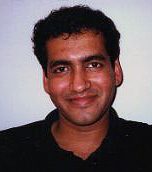
M.V. Ramana
This feature is occasioned by the birthday of the vaggeyakara [1] or composer who has had the greatest influence on Carnatic music – Tyagaraja.
Though the annual Tyagaraja aradhana at Tiruvayyaru takes place typically in late January, scholars generally agree that he was born on 4 May 1767 [2]. The eighteenth century was an interesting period in Carnatic music. Starting in the 16th century, composers like Muthu Tandavar and Margadarsi Sesha Ayyangar had experimented with the kriti format and the characteristic pallavi-anupallavi-charanam structure, one that was followed in Kshetragna‘s padas. These set the stage for Tyagaraja, as well as Muthuswami Dikshitar and Syama Sastry, to perfect this format with the result that it dominates Carnatic music today.
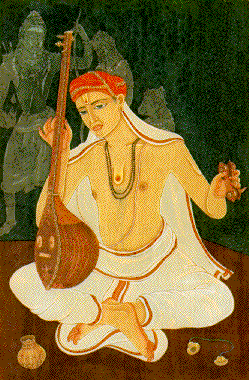
Tyagaraja’s outstanding contribution to the advancement of the kriti format was the introduction of the sangati (lit. coming together) – a set of variations on a theme, gradually unfolding the melodic potential of the musical phrase. Largely set in the madhyamakala (middle tempo), Tyagaraja’s kritis were more appropriate for the modern concert paddhati. As vidwan G. N. Balasubramaniam observed during his presidential address at the 32nd conference of the Music Academy in 1958, nearly 60% of Tyagaraja’s kritis are composed in this kala and this speed “seems to be the best for both the lay and the learned listeners.”
The 18th century was also witness to the virtual explosion of new ragas in the aftermath of Venkatamakhi‘s celebrated Chaturdandi Prakasika (ca. 1660) and his 72 melakarta scheme of classification [3]. Following and furthering the work of Venkatamakhi, Govinda (Govindacharya), in his Sangraha Chudamani (late 17th – early 18th century) introduced the sampoorna melakarta scheme as well as lakshanas for 294 janya ragas, many of which were unknown [4]. Thus, unlike Purandaradasa and musicians of his generation, who had perhaps a couple of dozen ragas to work with, Tyagaraja could experiment with hundreds.
Indeed Tyagaraja seems to have adopted composing in new ragas as one of the aims of his musical career. The 700 odd known kritis of Tyagaraja feature 212 ragas; 121 of these ragas have only one composition in them [5]. He was the first to compose kritis in “about 66 ragas” [6]. His enthusiasm for such ragas can be seen from the fact that even among the last few kritis that he is believed to have composed, three are in new ragas: Vagadeeswari (paramatmudu…), Ganavaridhi (daya juchutakidi velara…) and Manohari (paritapamu ganiyadina…). Dr. S. Ramanathan in one of his popular and insightful lecture demonstrations on “A Day With Tyagaraja” describes briefly how Tyagaraja followed the path laid out by Venkatamakhi. He then proceeds to illustrate this by singing the aforementioned kriti in Ganavaridhi (daya juchutakidi velara…).
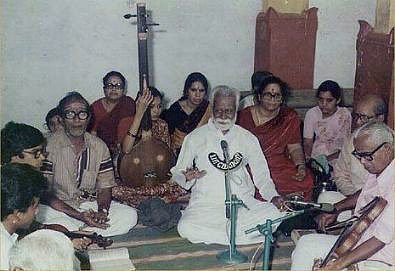
Dr. S. Ramanathan: Lecturing and Demonstrating to his
students. At his left, Mayuram Vaidyanatha Iyer
By composing excellent kritis, Tyagaraja gave life to these ragas. From being mere descriptions in a book (with at best a lakshana gita), these scales became full-fledged ragas capable of being sung elaborately in concerts. Tyagaraja, it must be remembered, was not only a composer but also a musician par excellence. Prof. P. Sambamoorthy narrates a story that sheds some light about Tyagaraja’s prowess as a performer. When Tyagaraja visited Madras on his way to Tirupati, he stayed at the house of Kovur Sundara Mudaliar, a musical patron. Madras, at that time, was on its way to becoming a musical center. For six evenings in succession, Tyagaraja sang the raga Devagandhari elaborately following it up with one of his compositions in the raga [7]. This incident testifies to the creative ability or manodharma of Tyagaraja, the musician [8].
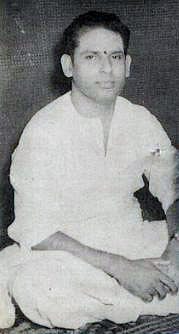
Nedunuri Krishnamurthy
A composer’s manodharma is evident in his or her compositions. The performer’s manodharma, on the other hand, is displayed during expositions of raga alapana, neraval or swara kalpana. One important musical resource that performers dip into for these expositions is the huge repertoire of kritis that have been built up since the 18th century and the period of the trinity. It is in this context that we wish to highlight Tyagaraja’s contribution in furthering the creative aspects of Carnatic music. We attempt to do this by exploring how relatively “minor” ragas that were pioneered by Tyagaraja have developed over the years, offering scope for elaborate and substantial renditions.
In some of these minor ragas, Tyagaraja’s composition(s) remain(s) the only one(s) that are heard publicly with any reasonable frequency. This is not to say that there are no other compositions in these ragas, but that these have not become popular. An example of this is the recording presented at the beginning of this feature, janaki ramana… in the raga Shuddha Seemantini performed by Nagaswara Chakravarthy T. N. Rajaratnam Pillai. Examples of such ragas are Jayantasena (vinata sutavahana…), Kapinarayani (sarasa samadana…), and Vijayasri (varanarada…). Though this particular rendition of janaki ramana… includes only a short alapana, several artistes have sung this composition elaborately, usually with neraval and swarams. In this feature, however, we focus on ragas that were pioneered by Tyagaraja, but handled by subsequent composers.
We begin with the raga Nalinakanti. The nominal arohana/avarohana is
s G3 R2 M1 P N3 s” s” N3 P M1 G3 R2 s.
The contours of this raga, as we know them today are undoubtedly shaped by Tyagaraja’s manaviyala… where he defines the raga in the very first phrase,
M1 G3 R2 s G3 – R2 M1 – M1 P – (P N3 P) M1 G3 R2 s G3
Phrases such as s G3 – R2 M1 – R2 P – M1 P N3 P M1 G3, and in the uttaranga, N3 R2″ N3 P M1, N3 G3″ R2″ N3 R2″ N3 P M1 etc., add color to the raga. Such phrases occur frequently in swaraprastara (for which this raga is ideally suited). In recent decades, Nalinakanti has been a favorite of two vocalists, Nedunuri Krishnamurthy and Vairamangalam Lakshminarayanan.
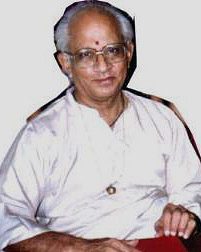
Tiruppugazh Raghavan
In the following clip, we hear Nedunuri Krishnamurthy‘s rendition of manaviyala… Lalgudi Jayaraman accompanies him on the violin, and Palghat Raghu on the mridangam.
Following Tyagaraja, several composers such as Mysore Vasudevacharya, G. N. Balasubramaniam, Lalgudi Jayaraman, Calcutta Krishnamurthy, Tanjavur Sankara Iyer, and Spencer Venugopal have composed in Nalinakanti. We offer two of these below. The first is the kriti nee padame … composed by G. N. Balasubramaniam (GNB). GNB follows Tyagaraja’s footsteps in defining the raga in the very first phrase of the song. However, he does it slightly differently, reversing the order: N3 P M1 G3 R2 s s G3 R2 M1 P N3 s” with an intelligent use of swarakshara (N3 P in nee pa..) and the introduction of the raga mudra.
Vairamangalam Lakshminarayanan presents this song in the following clip. Lalgudi Jayaraman accompanies him on the violin and Trichy Sankaran on the mridangam.
Tanjavur Sankara Iyer‘s kriti, natajana palini … is set to a slower tempo. In the following clip, we present a concise alapana by V. V. Ravi on the violin as a prelude to this kriti.
This recording is from a live concert where Neyveli Santanagopalan sings Sankara Iyer’s natajana palini … T. K. Murthy Iyer plays the mridangam. Santanagopalan uses the uttaranga phrases in the caranam of the kriti to launch into neraval and swaraprastara.
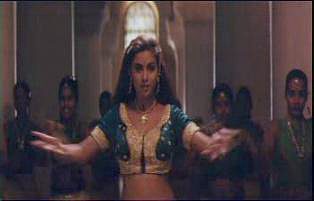
Simran dances to the tune of Nalinakanti
An example of a brief alapana in this raga is offered in the following clip of M. L. Vasantakumari (MLV). M. S. Anantharaman accompanies her on the violin.
As an example of how this raga can be used to tune lyrics, we present a clip of Tiruppugazh Raghavan teaching his students, the Tiruppugazh [9] udaiyavargaL eva …
The attractiveness of this minor raga has even persuaded modern [10] music composers to adopt it for film music. Inspired by Tyagaraja’s manaviyala …, Deva offers us this song sung by P. Unnikrishnan.
This popular song – made even more popular by the graceful dancing of one of the leading actresses in Tamil movies, Simran [11] – is in the movie nerukku ner. Harini sings the same song.
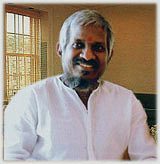
Ilayaraja
Ilayaraja‘s endan nenjil … is a more faithful representation of Nalinakanti as this clip demonstrates [12]. The singers are K. J. Yesudas and S. Janaki.
Our next choice is the raga Andolika. Once again, our perception of this raga is shaped by Tyagaraja’s raga sudharasa … A nominal arohana/avarohana can be deciphered from the kriti to be s R2 M1 P N2 s” s” N2 D2 M1 R2 s. Panchama and Shadja varjya prayogas are often used. It is said that the raga was a favorite of the great Vidwan, Kanchipuram Naina Pillai, who is said to have sung it elaborately on many occasions. Unfortunately, we do not have any recordings of his. Instead we present an excerpt of Tyagaraja’s kriti, raga sudharasa … sung by Madurai Somasundaram [13], a student of Chittoor Subramania Pillai, who in turn was trained by Naina Pillai. Again, we note how Tyagaraja establishes the structure of the raga in the opening phrase, N2 D2 M1 R2 s R2 M1 P.
Amongst others who have composed in Andolika are Harikesanallur Muthiah Bhagavatar, G. N. Balasubramaniam, Lalgudi Jayaraman, and Calcutta K.S. Krishnamurthy. The modern treatment of Andolika is undoubtedly influenced by GNB’s conception of the raga – clearly one of his favourites. This won admiration from Bade Ghulam Ali Khan, the great Hindustani vocalist and a GNB rasika, who, according to K. S. Muthuraman, was enamored of GNB’s rendering of Andolika and learnt it from GNB [14]. This recording, from a live concert in Pudukottai, explains why. First we present GNB’s alapana…
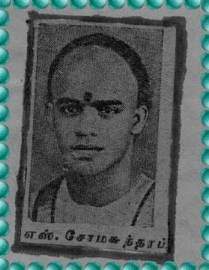
Madurai Somasundaram (circa 1940)
…followed by Lalgudi Jayaraman‘s reply on the violin.
The kriti, raga sudharasa …. Ramanathapuram C. S. Murugabhupathy plays the mridangam.
A more structured version of GNB’s imagination is displayed in his tana varnam in Andolika, nee daya rada … It is an attestation to the respect with which GNB was held in the musical world, that this was often sung by people like D. K. Jayaraman, who belonged to a different school or bani of music. (Another case of the same phenomenon was the earlier example of Vairamangalam Lakshminarayanan‘s rendition of nee padame …)
The above recordings show how an intelligent musician can benefit from Tyagaraja’s musical vision. This point is made again by MLV‘s exposition of Andolika. The alapana we present below is excerpted from a Ragam/Tanam/Pallavi in Andolika. M. S. Anantharaman accompanies her on the violin.
The next clip in Andolika features Muthu Tandavar‘s [15] composition, sevikka vendum … sung by Madurai Mani Iyer. (Though Muthu Tandavar predates Tyagaraja, this composition was tuned much later to Andolika, quite likely in the early part of this century after the raga had become very popular.)
Yet another Tiruppugazh offering from Raghavan.
We now turn our attention to Tyagaraja’s compositions in the melakarta ragas. Tyagaraja pioneered the use of several janaka ragas like Ramapriya (52), Dhenuka (9), Kiravani (21) and Chakravakam (16) [16]. In addition, Tyagaraja also composed in many vivadi melas such as Naganandini (30), Jhankaradhvani (19), Gangeyabhushani (33), Manavati (5) and Vagadeeswari (34). As an example we present the raga Kantamani, the 61st melakarta raga. Kantamani belongs to the same chakra as the popular raga Kalyani [17]. Like Kalyani, the raga employs R2 G3 M2 and P. However, in the upper tetrachord, Kantamani uses the swaras D1 and N1. In other words, its nishadam is at the same sthana as the dhaivata of Kalyani. Another kriti of Tyagaraja, edari … is often sung in Kantamani or its janya, Srutiranjani.
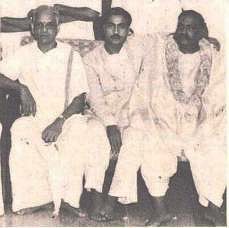
GNB (left), Munawar Ali Khan (centre),
Bade Ghulam Ali Khan (right)
In the following recording, Tanjavur S. Kalyanaraman sings Tyagaraja’s palintuvo … in the raga Kantamani. M. S. Gopalakrishnan plays the violin, and Vellore Ramabhadran, the mridangam.
We now move on to a different facet of Tyagaraja’s explorations. Prior to Tyagaraja, as a rule all ragas had at least 5 swaras in the arohana and avarohana. Tyagaraja was the first to introduce ragas that use just 4 notes. However, his experimentation was limited to two ragas, both of which have 4 notes in the arohana but to “make up”, have 6 in the avarohana [18]. The two ragas with this characteristic that Tyagaraja handled were Vivardhani and Navarasa Kanada. The latter raga has become very popular and has an arohana/avarohana
s G3 M1 P s” s” N2 D2 M1 G3 R2 s.

Kotiswara Iyer
The jump to the tara stayi shadjama from the panchama, and the skipping of the panchama in the avarohana impart tonal color to this raga. Here again, Tyagaraja exploits the medium of the kriti to shape the raga. The very first line of the kriti, paluku kanda … defines the arohana/avarohana as can be heard in this recording. The veteran vocalist Alathur Srinivasa Iyer sings Tyagaraja’s paluku kanda …
Another kriti of Tyagaraja, ninnu vina … is very popular with instrumentalists, especially flautists. However, we present another veteran vocalist, Trichy Swaminatha Iyer singing this kriti. But first, we present a brief alapana by Swaminatha Iyer and T. N. Krishnan.
The kriti, ninnu vina …
Subsequent to Tyagaraja, several composers have handled Navarasa Kanada. Some of them are Veenai Sesha Iyer, Nilakanta Sivan, Swati Tirunal, Harikesanallur Muthiah Bhagavathar, Papanasam Sivan, Mysore Vasudevacharya, Calcutta K. S. Krishnamurthy, and D. Pattammal [19]. We present a few examples below.
The first is Swati Tirunal‘s vande sada padmanabham … sung by T. K. Rangachari.
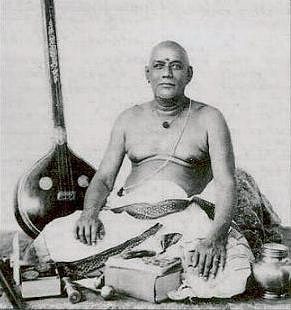
Harikesanallur Muthiah Bhagavatar
Harikesanallur Muthiah Bhagavathar‘s parasu hastaya … sung by Madurai Balasubramaniam.
Among more recent creations, Papanasam Sivan‘s [20] kriti, naan oru … enjoys great popularity [21]. D. K. Pattammal and D. K. Jayaraman sing Papanasam Sivan’s naan oru … Tirupparkadal Veeraraghavan plays the violin and Palghat Mani Iyer accompanies on the mridangam.
We now consider another raga whose treatment was pioneered by Tyagaraja. There is but a single kriti of Tyagaraja in the raga Ranjani. Today, there are as many as a hundred that have been compiled. Ranjani is a pratimadhyama raga with a nominal arohana/avarohana,
s R2 G2 M2 D2 s” s” N3 D2 M2 G2 s – s R2 G2 s.
Sometimes the vakra prayoga in the avarohana also appears as D2 M2 G2 s – s R2 s. The vakra prayoga, the jump from G2 to M2, and the absence of the panchama makes it a difficult raga to handle. However, Ranjani lives up to its name and is a very beautiful raga. Rangaramanuja Ayyangar, the author of the Kritimanimalai [22] series of books that presented hundreds of compositions with notation, many of them rare, mentions this incident about Simizhi Sundaram Ayyar, one of the great vidwans who lived in the first few decades of the 20th century [23]: ” … I once traveled with him in a train. We were on our way to his recital later in the evening. I sang a Kriti which caught his fancy. A man of few words, he was quite brief in his expression of appreciation. But I could see that he was rolling the song in his mind. What was my surprise when he did the song in his recital later in the evening, with ample justice to Ragam, Neraval and Swaraprastara! It was Durmargachara in Ranjani. It came into vogue ten years later.”
Though not mentioned, we suspect that the time frame was sometime around 1910-1920.
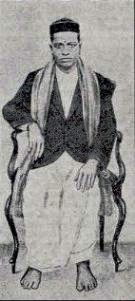
Simizhi Sundaram Iyer
In the decades that followed, durmargachara was often heard in concerts. For a whole generation of listeners, the musician who epitomised the song, and the raga in general, was Madurai Mani Iyer. Not only did Mani Iyer’s LP recording of “durmargachara” find a place in many a record collection, but rasikas also eagerly awaited his frequent inclusion of Ranjani during the ragamalika swara section of his Ragam-Tanam-Pallavi renditions. Here, however, we present Tyagaraja’s kriti sung by a contemporary vocalist, N. Vijay Siva. The recording is from a live concert at Boston University, 1993. He is accompanied by R. K. Shriram Kumar on the violin and J. Vaidhyanathan on the mridangam.
Once again we turn to the pioneer of “new” ragas – GNB. This quick sketch is from a viruttam and Lalgudi Jayaraman accompanies him on the violin.
In the following clip, GNB’s disciples, Tanjavur S. Kalyanaraman and Trichur V. Ramachandran sing a varnam in Ranjani, amboruha padame …, composed by their Guru.
Voleti Venkateswarlu offers a different look at Ranjani by emphasizing G2 and M2 in this alapana. Lalgudi Jayaraman accompanies him on the violin.
A kriti by Misu Krishna Iyer [24], parama pavana.
The next clip in Ranjani features a kriti, conceived beautifully by M. D. Ramanathan. We draw the listener’s attention to his intelligent use of M2, especially in the swaraprastara. MDR sings his own composition, mayamma … in Ranjani. M. S. Gopalakrishnan accompanies him on the violin, and Vellore Ramabhadran on the mridangam.
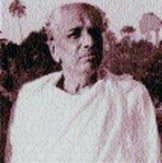
M.D. Ramanathan
A Tiruppugazh tuned in Ranjani by Raghavan.
Ranjani is also frequently heard in ragamalikas and we offer a very popular one composed by Tanjavur Sankara Iyer sung by D. K. Jayaraman.
The final raga taken up in this section is Janaranjani. The conception and creation of this raga is yet another demonstration of Tyagaraja’s musical acumen. As Prof. S. R. Janakiraman [25] explains, Tyagaraja derived Janaranjani and Purnachandrika from the older version of Purnachandrika.
Prof. S. R. Janakiraman explains and sings the older scale of Purnachandrika, handled by Muthuswamy Dikshitar in his kriti, shankha chakra … in this clip.
Prof. Janakiraman emphasizes the lakshana of Janaranjani once again.
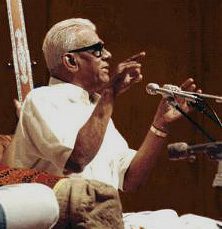
Prof. S. R. Janakiraman
The attractiveness of Janaranjani is underscored by the fact that Syama Sastry also composed one kriti, nannu brova… in this invention of Tyagaraja. We have it on reliable authority that the two composers did frequent each other’s company and listened to each other’s music. Syama Sastry even sent his son Subbaraya Sastry to study music from Tyagaraja [26]. So it is quite conceivable that Syama Sastry heard this raga from Tyagaraja and was inspired to compose his piece.
Semmangudi Srinivasa Iyer sings one of Tyagaraja’s most popular kritis in this raga, smarane sukhamu ... Lalgudi Jayaraman plays the violin and Umayalpuram Sivaraman, the mridangam.
Sanjay Subhramanyam takes up Janaranjani for elaboration in this live concert at Ayodhya Mandapam, Chennai (1996). Tirupparkadal Veeraraghavan plays the violin, and T. K. Murthy Iyer plays the mridangam. Sanjay’s alapana is evidently inspired by the musical possibilities offered by the kriti, nadadina … by Tyagaraja.
Tyagaraja’s kriti nadadina … follows the alapana. Note the kalapramana of the kriti. One of the differences between Janaranjani and Tyagaraja’s Purnachandrika is that the former is sung at a slower tempo than the latter is. Murthy Iyer offers perfect accompaniment on the mridangam without accelerating the pace. We also draw the attention to the neraval where Murthy Iyer plays different patterns for the “aruti” (the conclusion of the phrase taken up for neraval).
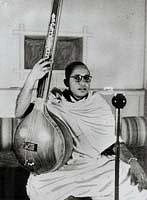
Semmangudi Srinivasa Iyer
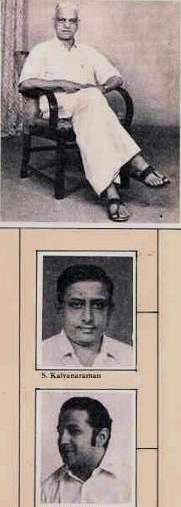
GNB (top), S. Kalyanaraman (middle)
and Trichur Ramachandran (bottom)
Our final offering in Janaranjani is the composition pada yugamunu …. The composer is M. D. Ramanathan and he sings his kriti in a concert at the Madras Music Academy. Lalgudi Jayaraman plays the violin and Coimbatore Ramaswamy, the mridangam.
The influence of Tyagaraja on contemporary Carnatic music that we have discussed above is due to many reasons. Among them is the role of his many disciples [27] in popularizing his music, and thus in popularizing the new ragas that Tyagaraja pioneered. Some of them have offered their tribute to Tyagaraja in the form of kritis expressing his greatness.
In this final section, we present a few of these.
The first is a kriti in the raga Devagandhari (a favorite of Tyagaraja as mentioned above) composed by his cousin and disciple Manambucavadi Venkatasubba Iyer [28].
T. N. Seshagopalan sings satguru swamikki … in the raga Reetigaula. The kriti is a tribute to Tyagaraja and composed by Ramnad (Poochi) Srinivasa Ayyangar, a disciple of Venkatasubbayyar’s student Patnam Subramania Iyer, and thus a great grand disciple of Tyagaraja.
Other composers, not necessarily belonging to the direct sishya parampara of Tyagaraja have also offered their tribute. The author of Kanda Ganamudam, Kotiswara Iyer composed the following kriti after being blessed (by Tyagaraja) in his dreams [29]. In his kriti ini namakku … in the raga Bilahari, Kotiswara Iyer recounts this incident. T. N. Seshagopalan presents this kriti.
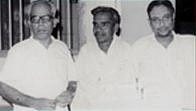
D. K. Jayaraman (right) with
Tanjavur Sankara Iyer (center)
Musicians, of course, owe a huge debt to Tyagaraja. S. Pasupathy [30] makes this point through this amusing limerick,
There was a bard of great fame
‘Sacrifice-King’ was his name
Artists make a living
use his kriti-s for singing
But he gets no fee, true to his name!
(No royalty to a raja? Is it not a shame?)
We present a couple of examples where the musician presents a tribute to Tyagaraja in the form of a (Ragam, Tanam) Pallavi. The first of these is in the raga, Simhendramadhyamam and Tanjavur S. Kalyanaraman pays homage to Tyagaraja in a pallavi whose lyrics are satguru sri tyagarajam bhajare … Nagai Muralidharan and Mannargudi Easwaran accompany him in this recording.
We present yet another recording from T. N. Seshagopalan. The pallavi in the raga Begada rama bhakta tyagaraja … is a tribute to Tyagaraja.
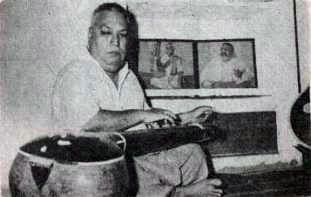
Voleti Venkateswarulu and his musical heroes (Ariyakudi
Ramanuja Iyengar (left) and Bade Ghulam Ali Khan (right)
An unusual form of homage, as well as an attestation of how Tyagaraja’s music captivated even musicians not trained in the Carnatic music, is Ustad Abdul Karim Khan‘s presentation of Tyagaraja’s Kharaharapriya kriti, rama nee samanamevaru …
Inspired by Tyagaraja’s kriti in Poornashadjam, lavanya rama, Rabindranath Tagore composed a song e ki labanya which we offer next. The singer is Swagatalakshmi Dasgupta.
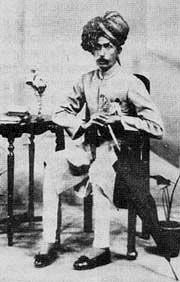
Abdul Karim Khan
Concluding this feature, we leave the reader with a sloka composed by one of Tyagaraja’s disciples, Wallajahpet Krishnaswamy Bhagavatar, in honor of his Guru. Prof. S. R. Janakiraman explains the sloka in this clip.
Acknowledgments
We thank A. S. Maniyam and N. Sivakumar for providing us with some recordings for this feature, Raju Asokan, Unnikrishnan and Ashwin Iyer for allowing us access to their album of photographs. We acknowledge various discussions with Ram Naidu and S. Pasupathy. We thank Samir Bhattacharya for drawing Tagore’s work to our attention and mailing us a recording of Tagore’s songs based on Carnatic kritis. We are grateful to Rajan P. Parrikar and Anita Thakur for their invaluable assistance in putting this feature together.
Footnotes
[1] The best compositions in Carnatic music are the creations of a single individual; this makes them an organic whole, consisting of both the lyrics (vak or datu) and the tune (geya or matu), often with intrinsic variations (sangati-s). It is for this reason that the great composers of Carnatic music are known as vaggeyakara-s, the creators of words and tunes.
[2] William L. Jackson, Thyagaraja: Life and Lyrics (New Delhi: Oxford University Press, 1991), p. 30. Prof. Jackson’s book is one of the few that attempt to locate Tyagaraja in a socio-historical setting.
[3] “The modern period in the history of music may be said to have been ushered in with the publication of Chaturdandi Prakasika in 1660… With the help of 12 svarasthanas and 16 svara names he (Venkatamakhi) formulated the scheme of the 72 melakartas… and made it so comprehensive, that it is impossible for any one to add to or to subtract even one from among them.” V. Premalatha, Music Through the Ages (Delhi: Sundeep Prakasan, 1985), p. 361.
[4] V. Premalatha, Music Through the Ages (Delhi: Sundeep Prakasan, 1985), p. 363.
[5] K. R. Rajagopalan, “Kritis of Tyagaraja – An Analysis,” Journal of the Music Academy 39 (1968), pp. 112-167.
[6] S. R. Janakiraman, “An Analytical Study of Tyagaraja’s Compositions,” Journal of the Music Academy 53 (1982), pp. 126-135, p. 135.
[7] P. Sambamoorthy, History of Indian Music (Madras: Indian Music Publishing House, 1960), p. 143.
[8] Other such anecdotes are narrated in P. Sambamoorthy, Great Composers Book 2 Tyagaraja (Madras: Indian Music Publishing House, 1970).
[9] For a comprehensive web site on Tiruppugazh and other works of Arunagirinathar, we direct the reader to https://www.kaumaram.com
[10] The adjective is used because, modern composers of film music seldom seem to use these themes unlike older composers who based the bulk of their songs on Carnatic ragas and folk music.
[11] The photograph of the actress is from the website: https://www.simranonline.com
[12] For an article on Ilayaraja’s musical capabilities, see: https://www.raajangahm.com/articles/frontline_evolution.html
[13] https://communities.msn.com/MaduraiSomuHomePage/_whatsnew.msnw
[14] Sruti (May 1984), p. 32.
[15] https://www.geocities.com/m_v_ramana/pret_tamil.html
[16] U. V. Swaminatha Iyer recounts the incident when Maha Vaidhyanatha Iyer sang Chakravakam elaborately to the puzzlement of the many famous musicians assembled in the Tiruvaduturai Adeenam. Reflecting the fact that Maha Vaidhyanatha Iyer was a grand disciple of Tyagaraja, Peria Vaithi, one of the prominent musicians present, referred to this raga as “Tanjavur sangati”. U. Ve. Swaminatha Iyer, Sangeeta Mummanikal (in Tamil) (Chennai: Doctor U. Ve. Swaminatha Iyer Noolnilayam, 1987), p. 192.
[17] Kalyani.
[18] Since then, composers like Balamuralikrishna have experimented with ragas that have only 4 notes in both arohana and avarohana.
[19] Alphabetical Index of Karnatak Songs, Part 2, compiled and published by Lakshman R. Ragde.
[20] Papanasam Sivan – Inspirations And Expressions
[21] For the story behind the song, see the article Margazhi Bhajanai https://www.geocities.com/m_v_ramana/karnatic.html
[22] Rangaramanuja Ayyangar, Sri Kritimanimalai (Bombay: Published by Smt. Padma Varadhan, 1987)
[23] R. Rangaramanuja Ayyangar, Musings of a Musician: Recent Trends in Carnatic Musician (Bombay: Wilco Publishing House, 1977), p. 17.
[24] The compositions of Misu Krishna Iyer were set to music by Alathur Venkatesa Iyer, father of Alathur Subramania Iyer, one of the Alathur Brothers.
[25] For a web site containing some of Prof. S. R. Janakiraman‘s speeches, see: https://www.ecf.utoronto.ca/~iyer/
[26] R. Rangaramanuja Ayyangar, Sri Kritimanimalai, Part IV (Bombay: Published by Smt. Padma Varadhan, 1987), pp. v-vi.
[27] A list of Tyagaraja’s disciples can be heard here.
[28] Manambucavadi.
[29] For the lyrics with notation of this as well as other kritis of Kotiswara Iyer, including the compositions in the 72 melakarta ragas, see S. Rajam, Sri Koteeswara Iyer‘s Keerthanaigal (in Tamil) (Chennai: Rasikas, 1998).
[30] For S. Pasupathy‘s article on Tyagaraja and Tamizh, see: https://www.comm.utoronto.ca/~pas/pictures/thy_1.jpg
https://www.comm.utoronto.ca/~pas/pictures/thy_2.jpg
